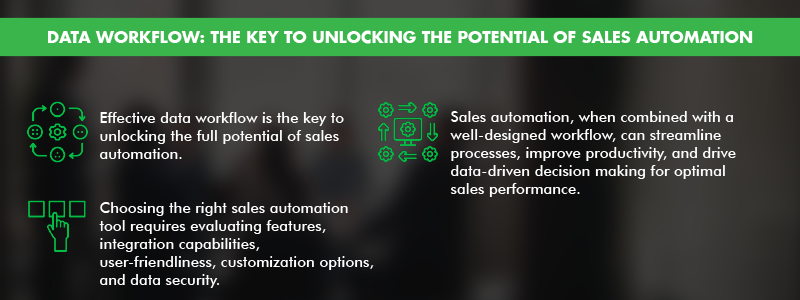Data Workflow: The Key to Unlocking the Potential of Sales Automation

Implementing an effective data workflow can unlock the potential of sales automation, streamline processes, and drive revenue growth. Here’s how.

Picture a modern business landscape where sales teams operate with unwavering efficiency, consistently achieving their targets and forging strong customer relationships. This is the potential of sales automation.
Sales automation is a game-changer for organizations seeking growth and scalability. However, merely implementing sales automation tools isn’t enough to unlock their true potential. You also need a robust and optimized data workflow.
In today's data-driven world, sales automation without a well-designed data workflow is akin to a high-performance engine without fuel. It may have great potential, but until you gas it up, it remains idle and ineffective.
In this blog post, we’ll dive headfirst into building an effective data workflow for sales automation. We’ll explore the ins and outs of data collection, integration, validation, cleansing, transformation, and accessibility with actionable insights to help you optimize your data workflow.
Understanding data workflow
A well-designed data workflow offers myriad benefits, starting with accurate and reliable data, which can give you a competitive advantage right off the bat. As Melody Chien, Senior Director Analyst for Gartner, puts it, “Data quality is directly linked to the quality of decision making. Good quality data provides better leads, better understanding of customers, and better customer relationships.”
But the advantages of a streamlined data workflow don’t stop there. By automating data collection and integration, you liberate your sales reps from the mundane task of manual data entry, allowing them to focus on what truly matters – building relationships and closing deals.
But the real magic happens when data workflow fuels personalized interactions. By leveraging data transformation and enrichment techniques, such as customer segmentation and profiling, you can unlock invaluable insights that enable you to customize your approach to each customer.
In today’s customer-centric world, personalization is no longer a nice-to-have; it’s an expectation. Research by Segment reveals that 7 out of 10 consumers want a personalized experience, especially when shopping. So you can supercharge customer satisfaction and conversion rates simply by infusing personalization into your sales automation through a robust data workflow.
Designing an effective data workflow
To get the most out of your automated sales tools, you need to make sure that the correct data is being collected, processed, and made accessible to fuel informed decision-making and drive personalized customer interactions. Here are the key steps involved in designing a robust data workflow:
1. Identify specific sales automation objectives and requirements
Understanding your unique business needs and goals guides the design of your data workflow. For example, if your primary objective is to improve lead generation and conversion, your data workflow should prioritize capturing and integrating data from various sources, such as website forms, social media platforms, and customer interactions.
2. Map out the data flow and integration points
Determine the sources and types of data you need to collect and the methods and intervals for data collection. This could involve integrating customer relationship management (CRM) systems, marketing automation platforms, and other data sources into a centralized system.
For instance, by integrating your CRM with your marketing automation platform, you can seamlessly capture lead data and track interactions throughout the sales process.
Then, implement robust data validation and cleansing processes within your workflow to ensure data accuracy and reliability. Here, you’ll verify data integrity, eliminate duplicates, and correct errors or inconsistencies.
Next, establish data governance policies and quality control measures. This way, you can maintain a high standard of data cleanliness and enhance the effectiveness of your sales automation efforts.
3. Choose the right tools and technologies
Select CRM systems, data integration platforms, ETL (Extract, Transform, Load) tools, and data quality solutions that align with your specific needs. The integration of these tools with your existing infrastructure should enable a seamless data flow and facilitate automation processes.
4. Ensure data security and compliance
Security and compliance should be integral to your data workflow design. Implement robust encryption and access control mechanisms to safeguard sensitive customer information. Ensure compliance with relevant data protection regulations such as GDPR and CCPA to build customer trust.
Remember, designing an effective data workflow isn’t a one-time task but an ongoing process that requires continuous evaluation and optimization to adapt to evolving business needs and technological advancements.
Choosing the right sales automation tools
Choosing the perfect sales automation tools is a make-or-break decision for your sales processes. With a sea of options out there, it's crucial to navigate the selection process with laser focus to find tools that align seamlessly with your goals. Here’s what to look for:
1. Integration capabilities:
Seamless integration with your existing software and other infrastructure is crucial for a smooth workflow and data synchronization.
2. Ease of use:
Look for software that’s user-friendly and intuitive. Your sales team should be able to adopt and utilize new tools with minimal training. A tool that offers a clean and intuitive interface, along with comprehensive documentation and customer support, will contribute to smoother implementation and increased adoption rates.
3. Customization and scalability:
Your sales processes and requirements may evolve, so you want tools that can adapt to your company’s unique needs and scale along with your business. Look for flexibility in customization options to tailor tools to your specific workflows and sales strategies.
4. Security and compliance:
When you’re handling sensitive and confidential information, you have to prioritize data security and compliance with relevant regulations (such as GDPR or CCPA). Look for features like data encryption, access controls, and audit logs to safeguard your data and maintain compliance.
Remember, there’s no one-size-fits-all approach when it comes to choosing the right automated sales tools. It requires a careful evaluation of your company’s unique needs, among many other factors. It can seem a little overwhelming at first, which is why it often pays to call in the experts.
How MetaGrowth can help
MetaGrowth Ventures has a wealth of experience in hiring, training, and managing expert sales teams.
Their deep understanding of the sales process and expertise in sales automation make them uniquely positioned to help businesses implement successful data workflows. They also provide invaluable guidance in developing a customized sales automation strategy, selecting the right tools, and seamlessly integrating them into existing systems.
If you’re ready to harness the power of automation, optimize your sales processes, and drive your business to new heights, book a consultation with the MetaGrowth team today.
Written by
Josh Hirsch
